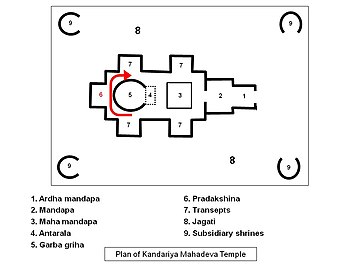Vaastu Shastra - Terminology and history:
Terminology
The Sanskrit word vastu means a dwelling or house with a corresponding plot of land.[23]The vrddhi, vāstu, takes the meaning of "the site or foundation of a house, site, ground, building or dwelling-place, habitation, homestead, house". The underlying root is vas"to dwell, live, stay, reside".[24] The termshastra may loosely be translated as "doctrine, teaching".
Vastu-Sastras (literally, science of dwelling) are ancient Sanskrit manuals of architecture. These contain Vastu-Vidya (literally, knowledge of dwelling).[25]
History
Historians such as James Fergusson,Alexander Cunningham and Dr. Havell have suggested that Vastu Shastra developed between 6000 BCE and 3000 BCE, adding that the archaeological sites of Harappa andMohenjo-daro stand on the principles of Vastu Shashtra.[26][verification needed]
Description

Ancient India produced many Sanskrit manuals of architecture, called Vastu Sastra. Many of these are about Hindu temple layout (above), design and construction, along with chapters on design principles for houses, villages, towns. The architect and artists (Silpins) were given wide latitude to experiment and express their creativity.[27]
There exist many Vastu-Sastras on the art of building houses, temples, towns and cities. One such Vastu Sastra is by Thakkura Pheru, describing where and how temples should be built.[9][28] By 6th century AD, Sanskrit manuals for constructing palatial temples were in circulation in India.[29] Vastu-Sastra manuals included chapters on home construction, town planning,[25] and how efficient villages, towns and kingdoms integrated temples, water bodies and gardens within them to achieve harmony with nature.[13][14] While it is unclear, states Barnett,[30] as to whether these temple and town planning texts were theoretical studies and if or when they were properly implemented in practice, the manuals suggest that town planning and Hindu temples were conceived as ideals of art and integral part of Hindu social and spiritual life.[25]
The Silpa Prakasa of Odisha, authored by Ramacandra Bhattaraka Kaulacara sometime in ninth or tenth century CE, is another Vastu Sastra.[31] Silpa Prakasa describes the geometric principles in every aspect of the temple and symbolism such as 16 emotions of human beings carved as 16 types of female figures. These styles were perfected in Hindu temples prevalent in eastern states of India. Other ancient texts found expand these architectural principles, suggesting that different parts of India developed, invented and added their own interpretations. For example, in Saurastra tradition of temple building found in western states of India, the feminine form, expressions and emotions are depicted in 32 types of Nataka-stri compared to 16 types described in Silpa Prakasa.[31]Silpa Prakasa provides brief introduction to 12 types of Hindu temples. Other texts, such as Pancaratra Prasada Prasadhana compiled by Daniel Smith[32] and Silpa Ratnakara compiled by Narmada Sankara[33] provide a more extensive list of Hindu temple types.
Ancient Sanskrit manuals for temple construction discovered in Rajasthan, in northwestern region of India, include Sutradhara Mandana’s Prasadamandana(literally, manual for planning and building a temple) with chapters on town building.[34]Manasara shilpa and Mayamata, texts of South Indian origin, estimated to be in circulation by 5th to 7th century AD, is a guidebook on South Indian Vastu design and construction.[9][35] Isanasivagurudeva paddhatiis another Sanskrit text from the 9th century describing the art of building in India in south and central India.[9][36] In north India, Brihat-samhita by Varāhamihira is the widely cited ancient Sanskrit manual from 6th century describing the design and construction ofNagara style of Hindu temples.[27][37][38]
These ancient Vastu Sastras, often discuss and describe the principles of Hindu temple design, but do not limit themselves to the design of a Hindu temple.[39] They describe the temple as a holistic part of its community, and lay out various principles and a diversity of alternate designs for home, village and city layout along with the temple, gardens, water bodies and nature.[14][40]
No comments:
Post a Comment